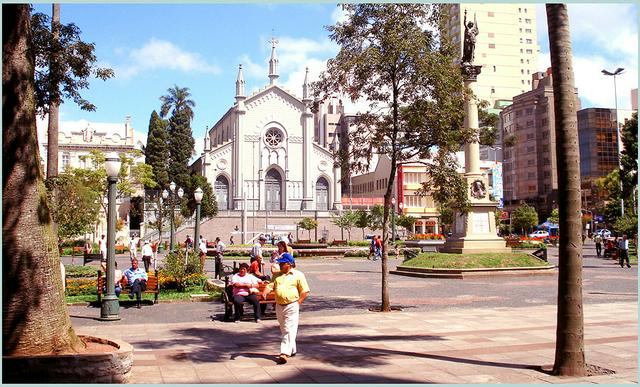
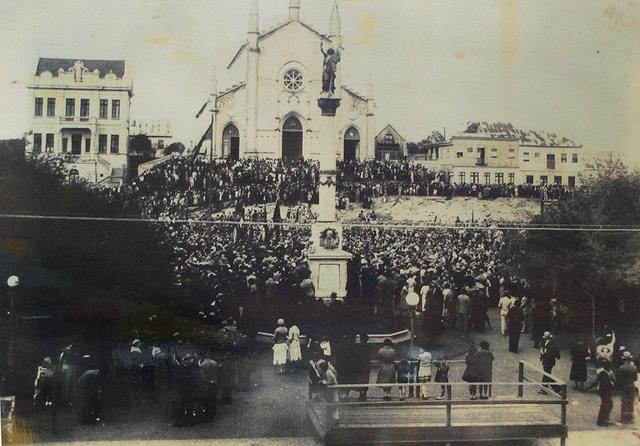
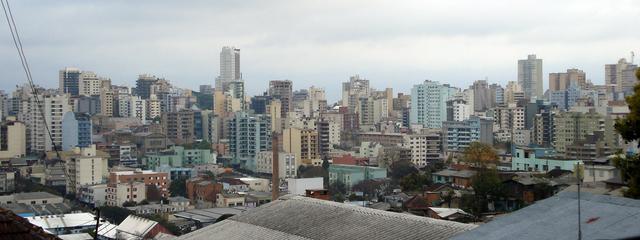 Caxias do Sul is the second largest city in the southern Brazilian state of Rio Grande do Sul after the capital city of Porto Alegre. It is a major industrial center in the region dealing mostly in metallurgy, bus manufacturing, and grape production. It is a strong center of Italian-Brazilian culture and seen as the Capital da Serra Gaúcha or Capital of the Gaucho Mountain Range. It is one of the wealthiest cities per capita in Brazil. It's also a sleepy and traditional Italian-type city.
Caxias do Sul is the second largest city in the southern Brazilian state of Rio Grande do Sul after the capital city of Porto Alegre. It is a major industrial center in the region dealing mostly in metallurgy, bus manufacturing, and grape production. It is a strong center of Italian-Brazilian culture and seen as the Capital da Serra Gaúcha or Capital of the Gaucho Mountain Range. It is one of the wealthiest cities per capita in Brazil. It's also a sleepy and traditional Italian-type city.
The history of Caxias do Sul starts before the arrival of the Italians, when the region was being roamed by cattlemen and occupied by Indians. Back then, the region was called "Indians' Field". The Italian immigrants' occupation, mostly farmers from the Veneto region (northern Italy), started taking place in 1875 in Nova Milano. Hence, they were in search of a better place to live. They also met people from Lombardy, Trento, and other places. Although they had gotten some governmental support, such as tools, supplies, and seeds, everything had to be reimbursed.
Two years later, the colonial headquarters of the Indians' Field was given the name Caxias Colony. The town was created on July 20, 1890 and acknowledged in the same year, on August 24. Many economic cycles marked the evolution of the city throughout that century. The first one is connected to the most peculiar aspect of its cultural identity: the growth of vines and the production of wine for own consumption at first, and later on, for commercialization.
On June 1, 1910, Caxias do Sul was elevated to the category of city. On the same day, the first train arrived connecting the region to the state capital. Although the immigrants were farmers, many of them used to perform other activities. They settled down, urbanized the region, and started a fast-paced process of industrialization.
In the countryside, subsistence agriculture concentrates on the cultivation of grapes, wheat, and corn. Home-based manufacturing started to emerge and the overproduction was commercialized. Home-based manufacturing and Caxias do Sul evolved from having small home-based workshops to today's big factories, which are known internationally.
Nowadays, Caxias do Sul is an important city, and due to its industrious colonists, is home to vast vineyards, wineries, a varied industrial park, and a rich and dynamic market. Those attributes grant this land great importance, the reason why Caxias do Sul, called "pearl of the colonies", is considered the center of the Italian presence in Southern Brazil.
Caxias do Sul is today the hub centralizing the region more diverse than Brazil, with its industrious settlers, its vast vineyards, his winery, his varied industrial park and a rich and dynamic trade, which gives the land a further dimension, why Caxias do Sul, the "Pearl of the Colonies", is, by itself, the pole centralizing the Italian brand in southern Brazil.
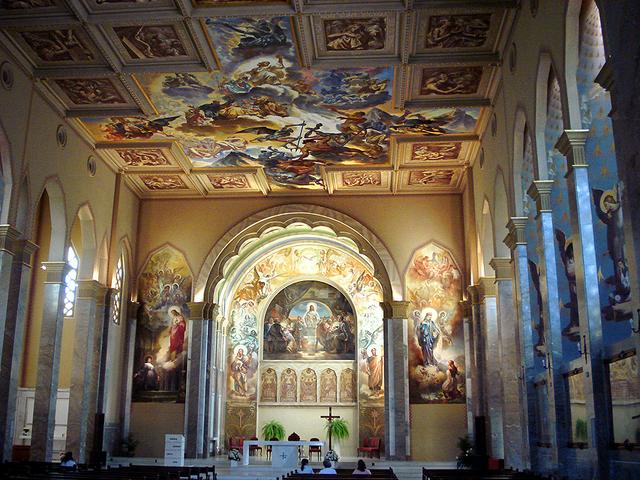
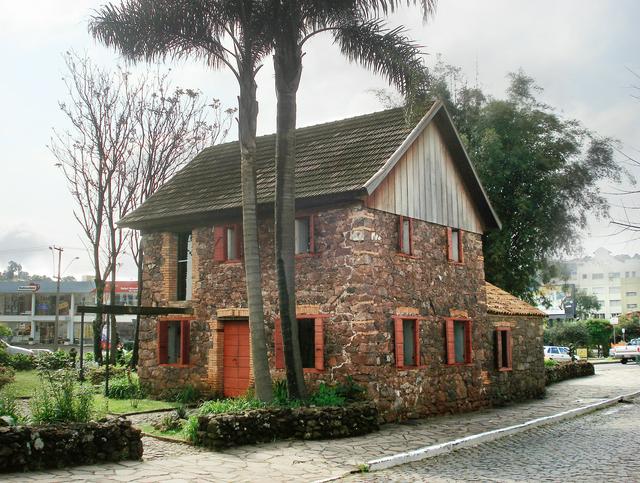

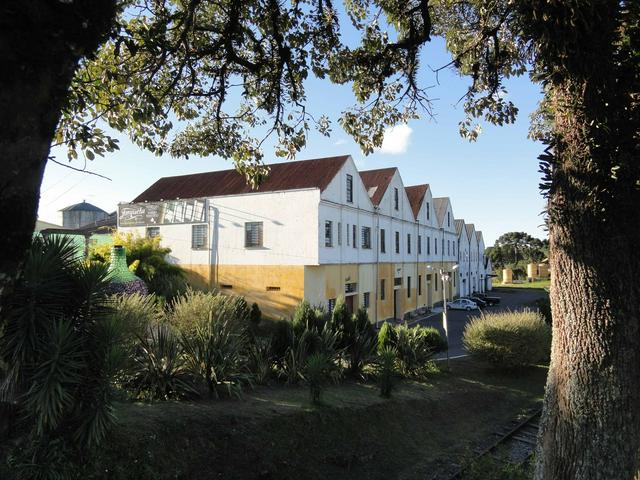
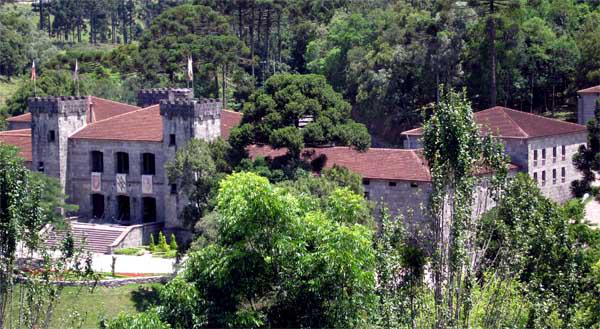
- Museu Casa de Pedra, Rua Matheo Gianella, 531. 09 to 17h. Built in 1878 by the Lucchese family, houses objects, furniture and utensils used by immigrants at the time of colonization. Considered a Living Museum in Latin America.
- São Pelegrino Church, Av. Itália, 54, B. São Pelegrino (Av. Itália, corner with Av. Rio Branco, +55 54 3221-2567. 8:00 - 18:00, generally closes at noon for lunch. Catholic cathedral which houses works by Italian-Brazilian artist Aldo Locatelli. In the lobby, there's a replica of the Pieta of Michelangelo, a gift from Pope Paul VI by occasion of the Centennial of the Italian Immigration. The high relief bronze doors show epic scenes of colonization times, and were created by artist August Murer.
- Replica of historic Caxias do Sul, Rua Ludovico Cavinatto, 1431 (beside the Grape Festival Pavilions. Architectural complex of 15 wooden houses, including a church and a bandstand, obeying strictly the standards prevailing at the time (1885), and reproducing the Julio de Castilhos Avenue.
- Roman Catholic Diocese of Caxias do Sul, Rua Sinimbu 1976-2108 (On Rua Sinimbu adjacent to Praça Dante Alighieri (central square of the city), +55 54 3221-2564. Inspired by the Basilica of St. Anthony in Bologna, was built in the Italian Gothic style, presenting ten altars: the main one and nine lateral ones.
- Municipal Museum, Rua Visconde de Pelotas, 586 - Centro, +55 54 3221-2423. The collection consists of pieces for the everyday life of settlers in the region, mostly Italian immigrants and acculturation with other neighboring groups. The museum functions as memory center of the city.
- Monumento Nacional ao Imigrante (National Monument to the Immigrant). Inaugurated in 1954, the monument celebrates the immigrants to the Brazilian nation, specifically, Italian immigrants in southern Brazil like those in Caxias do Sul. Parking is available.
- Museu de Uva e Vinho Primo Slomp (Museum of Grapes and Wine), Rua Luiz Franciosi Sério, 350 Bairro Forqueta (Located in Bairro Forqueta which is to the southwest of urban Caxias do Sul down RS-122.. Tuesday-Sundy, 9:00-17:00.
- Belvedere da Cascata Véu da Noiva (Bridal Veil Falls outlook) in Galópolis.
Museu Casa de Pedra, Rua Matheo Gianella, 531. 09 to 17h. Built in 1878 by the Lucchese family, houses objects, furniture and utensils used by immigrants at the time of colonization. Considered a Living Museum in Latin America.
São Pelegrino Church, Av. Itália, 54, B. São Pelegrino (Av. Itália, corner with Av. Rio Branco, +55 54 3221-2567. 8:00 - 18:00, generally closes at noon for lunch. Catholic cathedral which houses works by Italian-Brazilian artist Aldo Locatelli. In the lobby, there's a replica of the Pieta of Michelangelo, a gift from Pope Paul VI by occasion of the Centennial of the Italian Immigration. The high relief bronze doors show epic scenes of colonization times, and were created by artist August Murer.
Replica of historic Caxias do Sul, Rua Ludovico Cavinatto, 1431 (beside the Grape Festival Pavilions. Architectural complex of 15 wooden houses, including a church and a bandstand, obeying strictly the standards prevailing at the time (1885), and reproducing the Julio de Castilhos Avenue.
Roman Catholic Diocese of Caxias do Sul, Rua Sinimbu 1976-2108 (On Rua Sinimbu adjacent to Praça Dante Alighieri (central square of the city), +55 54 3221-2564. Inspired by the Basilica of St. Anthony in [[Bologna]], was built in the Italian Gothic style, presenting ten altars: the main one and nine lateral ones.
Municipal Museum, Rua Visconde de Pelotas, 586 - Centro, +55 54 3221-2423. The collection consists of pieces for the everyday life of settlers in the region, mostly Italian immigrants and acculturation with other neighboring groups. The museum functions as memory center of the city.
Monumento Nacional ao Imigrante (National Monument to the Immigrant). Inaugurated in 1954, the monument celebrates the immigrants to the Brazilian nation, specifically, Italian immigrants in southern Brazil like those in Caxias do Sul. Parking is available.
Museu de Uva e Vinho Primo Slomp (Museum of Grapes and Wine), Rua Luiz Franciosi Sério, 350 Bairro Forqueta (Located in Bairro Forqueta which is to the southwest of urban Caxias do Sul down RS-122.. Tuesday-Sundy, 9:00-17:00.
Belvedere da Cascata Véu da Noiva (Bridal Veil Falls outlook) in Galópolis.
- Castelo Lacave winery, BR 116 - Km 143, +55 54 4009-4822. The castle was built by Uruguayan businessman Juan Carrau from 1968-1978 in the style of an 11th century medieval castle and functions as an active winery. You can take a tour, sample wine or grape juice and eat at the restaurant located in the complex. R$10.00 for adults, R$5.00 children ages 6-11.
- Marcopolo Bus factory, Av. Rio Branco, 4889 - Bairro Ana Rech, +55 54 2101-4000. Tour the Marcopolo Bus Factory, one of the largest bus companies in the world.
- Festa da Uva (GrapeFest - occurs ever even-numbered year in February/March), R. Ludovico Cavinatto, 1431. This biennial agricultural convention celebrates everything from this Italian region of southern Brazil.
Castelo Lacave winery, BR 116 - Km 143, +55 54 4009-4822. The castle was built by Uruguayan businessman Juan Carrau from 1968-1978 in the style of an 11th century medieval castle and functions as an active winery. You can take a tour, sample wine or grape juice and eat at the restaurant located in the complex. R$10.00 for adults, R$5.00 children ages 6-11.
Marcopolo Bus factory, Av. Rio Branco, 4889 - Bairro Ana Rech, +55 54 2101-4000. Tour the Marcopolo Bus Factory, one of the largest bus companies in the world.
Festa da Uva (GrapeFest - occurs ever even-numbered year in February/March), R. Ludovico Cavinatto, 1431. This biennial agricultural convention celebrates everything from this Italian region of southern Brazil.
- Alameda Pizzeria, Rua Matteo Gianella, 1440, +55 54 3211-0102, +55 54 32113694.
- Churrascaria Gaudério, Rua Mário de Boni, 1766, +55 54 3225-1466.
- Cantina Pão e Vinho, Rua Ludovico Cavinatto, 1757, +55 54 3211-2500, +55 54 9917-8676. Mo-Sa, 11h30 til 14h /19h30 til 22h30.
- Chateau Lacave, BR 116, Km 143, s/nº, +55 54 4009-4800, +55 54 4009-4822. Su-Su, 11h30 til 15h / Te-Th, 19h30 til 22h / Fr-Sa, 19h30 til 23h.
Alameda Pizzeria, Rua Matteo Gianella, 1440, +55 54 3211-0102, +55 54 32113694.
Churrascaria Gaudério, Rua Mário de Boni, 1766, +55 54 3225-1466.
Cantina Pão e Vinho, Rua Ludovico Cavinatto, 1757, +55 54 3211-2500, +55 54 9917-8676. Mo-Sa, 11h30 til 14h /19h30 til 22h30.
Chateau Lacave, BR 116, Km 143, s/nº, +55 54 4009-4800, +55 54 4009-4822. Su-Su, 11h30 til 15h / Te-Th, 19h30 til 22h / Fr-Sa, 19h30 til 23h.
- La Barra.
La Barra.
- Havana Café.
- Voice Club Bistrô.
- Pepsi Club.
Havana Café.
Voice Club Bistrô.
Pepsi Club.
- Arena Country Bar.
Arena Country Bar.
Paiol Espaço Nativo.
- Bento Gonçalves - The Wine Capital of Brazil.
- Gramado - A German-themed tourist city on the Rota Romântica (Romantic Route).
- Canela - Gramado's sister city. There are plenty of eco-tourism opportunities here (river rafting, hang gliding, hiking) and one of the most beautiful waterfalls in the state at the Parque do Caracol.
